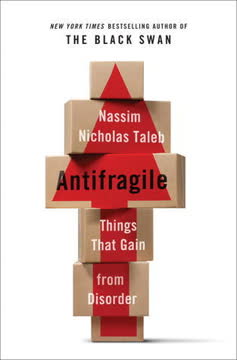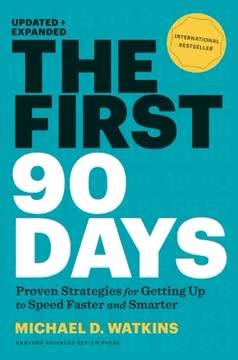Key Takeaways
1. Change is Constant: Embrace Problems as Opportunities
Since change is here to stay, problems are here to stay . . . Forever!!!
Problems are inevitable. Change is the only constant, and with change comes both opportunities and problems. The pursuit of a problem-free existence is futile; instead, organizations should embrace problems as a natural part of life and focus on developing the capacity to handle them effectively.
Problems as growth catalysts. Each problem presents an opportunity for learning, adaptation, and growth. By viewing problems as challenges to be overcome, organizations can foster a culture of innovation and resilience. The ability to solve increasingly complex problems is a sign of organizational strength and maturity.
Adapt or perish. The rate of change is accelerating, and organizations must be responsive to survive. Those that make the right decisions quickly and implement them effectively will thrive, while those that resist change will face decline and eventual demise.
2. Organizational Lifecycles: Predictable Stages of Growth and Decline
In this book, I present the theory of organizational lifecycles and the principles for leading organizational change that I have developed and practiced over the past thirty years.
Lifecycle stages. Organizations, like living organisms, progress through predictable stages of development, from Courtship and Infancy to Go-Go, Adolescence, Prime, Aristocracy, Bureaucracy, and ultimately, Death. Each stage presents unique challenges and opportunities.
Understanding the stages. Recognizing an organization's current stage in the lifecycle is crucial for identifying normal versus abnormal problems and implementing appropriate interventions. This knowledge allows leaders to anticipate challenges and proactively manage change.
Typical vs. optimal paths. Organizations can follow a typical path, encountering predictable problems at each stage, or strive for an optimal path, accelerating their progress to Prime and sustaining peak performance for a longer period. The optimal path requires a more integrated and proactive approach to management.
3. The PAEI Model: Four Essential Management Roles
The challenge of leadership on any level—individual, family, organization and society—is to change continuously and, nevertheless, always remain together!
Four key roles. For an organization to be effective and efficient in both the short and long term, four essential management roles must be performed:
- P (Producer): Focuses on achieving results and delivering on commitments.
- A (Administrator): Emphasizes efficiency, order, and control.
- E (Entrepreneur): Drives innovation, creativity, and risk-taking.
- I (Integrator): Fosters cohesion, collaboration, and a shared sense of purpose.
No one is perfect. No single individual can excel in all four roles simultaneously. Effective leadership requires a complementary team that embodies all four functions.
Dynamic balance. The relative importance of each role varies depending on the organization's stage in the lifecycle. Understanding these shifts is crucial for adapting leadership styles and strategies to meet evolving needs.
4. The Typical Path: A Sequential Approach to Growth
Most organizations follow a typical path. On that path, they encounter problems that exist because the organizations have yet to develop certain capabilities.
Sequential development. On the typical path, organizations develop the PAEI roles one at a time, progressing through the lifecycle stages in a predictable sequence. This sequential approach often leads to imbalances and predictable problems at each stage.
Growing pains. Each transition from one stage to the next is marked by specific challenges and difficulties. These "growing pains" are a result of the organization's efforts to adapt to new demands and develop new capabilities.
Example: Go-Go stage. In the Go-Go stage, organizations are characterized by rapid growth, a strong sales orientation, and a lack of systems and controls. This can lead to overextension, financial instability, and a loss of focus.
5. The Optimal Path: An Integrated, Accelerated Approach
There is an optimal path, presented here, which although it generates other problems, they are preferable to those on the typical path because they bring an organization to Prime faster and can keep it there longer.
Simultaneous development. The optimal path involves developing all four PAEI roles simultaneously, creating a more balanced and adaptable organization. This approach requires a high degree of integration and a proactive approach to managing change.
Faster to Prime. By following the optimal path, organizations can accelerate their progress to Prime, the stage in the lifecycle characterized by peak performance, adaptability, and sustainable success.
Integration is key. The optimal path emphasizes the importance of integration, fostering a culture of collaboration, mutual trust, and shared purpose. This allows organizations to leverage the strengths of all four PAEI roles and avoid the pitfalls of imbalance.
6. Organizational Aging: Recognizing and Reversing the Decline
Organizations can have normal and/or abnormal problems of growing. The problems of aging should all be considered abnormal because organizational aging can be averted with appropriate treatment.
Aging is not inevitable. Organizational aging is not a natural or unavoidable process. With appropriate interventions, organizations can retard or even reverse the decline and maintain their vitality.
Early detection is crucial. Recognizing the early signs of aging is essential for implementing timely interventions. These signs include a decline in innovation, a loss of focus, and an increasing emphasis on internal politics.
Curative and preventive treatment. Curative treatment involves removing abnormal problems and restoring the organization to a healthy state. Preventive treatment focuses on developing capabilities that enhance the organization's advance to Prime and sustain it there.
7. The Founder's Trap: A Common Pitfall and How to Avoid It
Founders are simultaneously their companies’ biggest assets and biggest risks.
Inseparability. The founder's trap occurs when an organization becomes overly dependent on its founder, hindering its ability to grow and adapt. This often happens when the founder's personal style and preferences become deeply ingrained in the organization's culture.
Delegation difficulties. Founders struggling with the founder's trap often have difficulty delegating authority and relinquishing control. This can stifle innovation and prevent the organization from developing the necessary managerial depth.
Institutionalizing leadership. To avoid the founder's trap, organizations must institutionalize leadership, separating ownership from management and developing a system of governance that is independent of any single individual.
8. The Importance of Integration: Building Cohesion and Adaptability
The challenge of leadership on any level—individual, family, organization and society—is to change continuously and, nevertheless, always remain together!
Counteracting disintegration. Change inevitably leads to disintegration, and organizations must actively work to reintegrate their systems and processes to maintain cohesion. This requires a focus on communication, collaboration, and shared purpose.
Internal vs. external integration. Internal integration focuses on building a strong organizational culture and fostering mutual trust and respect. External integration involves aligning the organization with its external environment and adapting to changing market conditions.
The role of leadership. Effective leaders are skilled at both internal and external integration, creating a cohesive and adaptable organization that can thrive in a dynamic environment.
9. Leadership Styles: Matching Leaders to Lifecycle Stages
What is normal at one stage of the lifecycle can be abnormal in another stage.
Contingency approach. There is no one-size-fits-all leadership style. The most effective approach depends on the organization's stage in the lifecycle and its specific needs.
Evolving leadership. As organizations progress through the lifecycle, their leadership needs change. Founders who excel in the early stages may not be the best leaders for later stages, requiring a transition to professional management.
Complementary teams. Effective leadership often involves a complementary team that embodies all four PAEI roles. This allows the organization to leverage the strengths of different individuals and avoid the pitfalls of a single, dominant style.
10. The Role of the Organizational Therapist: Guiding Change and Reintegration
The role of leadership is not to prevent the system from falling apart. On the contrary, it is to lead change that causes the system to fall apart and then to reintegrate it into a new whole.
Facilitating change. Organizational therapists, or consultants, play a crucial role in guiding organizations through periods of change and reintegration. They help organizations identify their current stage in the lifecycle, diagnose their problems, and implement appropriate interventions.
Distinguishing normal from abnormal. A key function of the organizational therapist is to differentiate between normal problems, which can be solved internally, and abnormal problems, which require external intervention.
Curative and preventive measures. Organizational therapists provide both curative treatment, addressing existing problems, and preventive treatment, developing capabilities that enhance the organization's long-term health and success.
Last updated:
Review Summary
Readers praise Managing Corporate Lifecycles as an insightful and essential guide for business leaders. Many consider it a must-read, highlighting its comprehensive framework for understanding organizational growth and change. The book's practical applications and case studies are particularly valued. Some readers find parts of the text tedious or overly complex, but most appreciate the author's systematic approach and unique perspective. The book is especially recommended for managers, consultants, and entrepreneurs seeking to navigate corporate challenges and foster sustainable growth.
Similar Books










Download PDF
Download EPUB
.epub digital book format is ideal for reading ebooks on phones, tablets, and e-readers.




